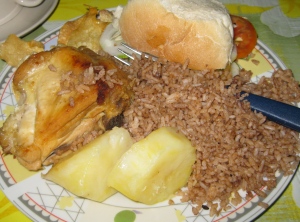
“Green plantains, perfect for tostones!”
I can always tell when my Cuban family is planning to make tostones, because the dad is out of the front porch in complete silence with a big knife peeling the plantains,
discarding the skins in a bag and meticulously placing the white plantains in a large pot to be rinsed later. According to the Cubans, it is bad luck to talk to someone when they are peeling plantains…a job that requires concentration so as to not cut the fruit.
Tostones are kind of like Cuban potato chips, only way better!!! These can be
prepared in a variety of ways. For example, using the small, fat plantains, (burros),
you can slice them lengthwise into narrow strips. (See picture) Or, using the large, traditional plantains (machos), you can chop the fruit into circles and smash them into disks half way through the frying process. Either way, the end result is the same!
At large Cuban gatherings in the past, tostones were prepared in mass quantities using the same frying oil used to prepare chicharron while the pig cooked over the spit. (Chicharron is a sinfully addictive but horribly fattening, artery-clogging, life
threatening snack that is scarily popular among Cubans…you basically take the
skin and fat of the pig and cut it into little pieces and fry it until crispy.) At these large Cuban parties, some of the skin and fat were removed from the pig before cooking to prepare the chicharron, and the tostones were later fried in the same grease while the chicharron cooled. Then the guests munched on tostones and chicharron while waiting for the pork and congris.
This is a great starter if you are planning on throwing a Cuban dinner party, and you can leave off the garlic and onion if you have any picky eaters coming for dinner.
“Tostones”
Tools:
- Large sharp knife
- Frying Pan
- Paring knife or garlic press
- Fork
Ingredients:
- GREEN Plantains (if the plantains are yellow or black they will be too sweet for tostones)
- Oil
- 4-5 cloves Garlic
- Small White onion
Preparation:
- VERY CAREFULLY peel the plantains. Be aware that they may secrete a sticky, white/milky substance, so wash the knife and your hands thoroughly after
peeling.
- Slice or cut plantains in desired manner
- Prep garlic and onion. Peel and chop. Set aside.
- Pour generous amount of oil in frying pan over medium heat (enough to cover the bottom of the pan and come at least half way up the plantains when added.)
- Add plantains to pan a few at a time, being careful not to overcrowd the pan.
- There should not be a sound like frying bacon, only a light sizzle. These need to cook slowly until they brown only slightly, if the oil is too high they will burn on the outside but not cook.
- Use a fork to flip plantains once bottom begins to brown. Remove after 1 or 2 minutes on the other side. Place on cooling rack or plate with paper towel (to collect oil) when done.
- When all tostones are ready, turn the flame to high and add garlic and onion to the hot oil. Swirl oil in the pan for 30 seconds to a minute, allowing the garlic and onion to cook only slightly, but maintain their crunch.
- Using a spoon, collect the garlic and onion with only a little oil and spoon over the tostones.
- Serve immediately.

“Crisp tostones with flash-fried garlic and










